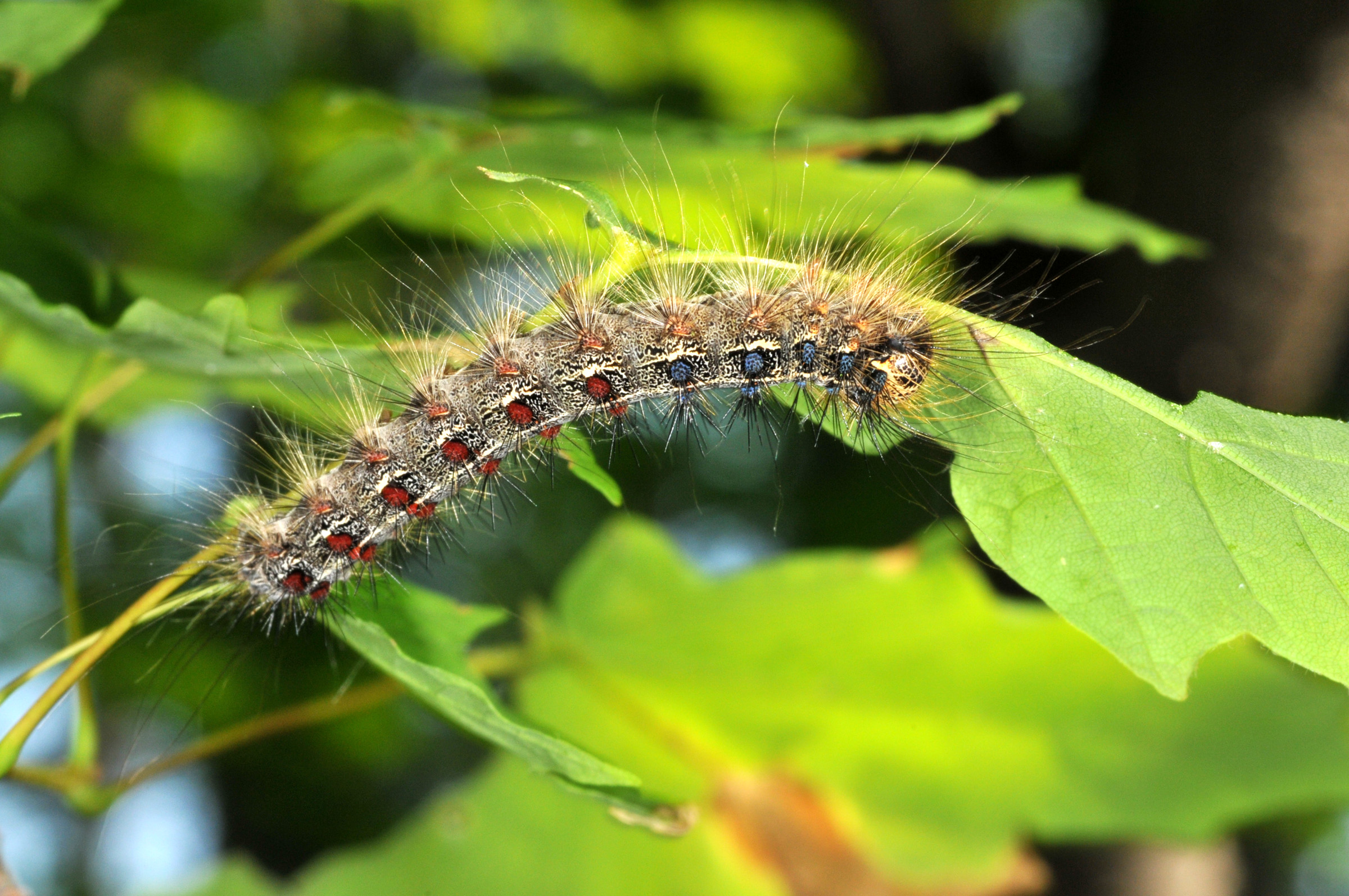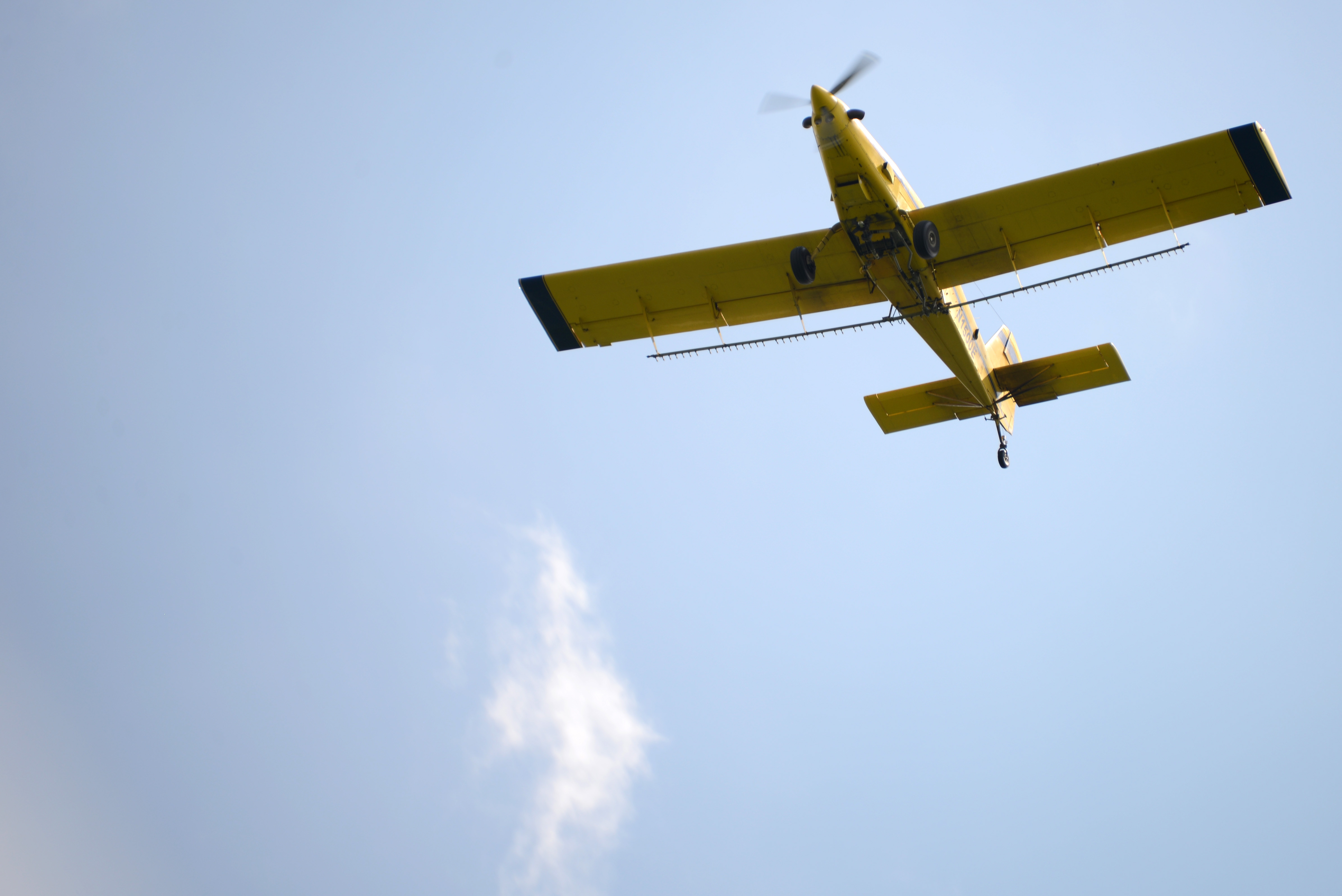SPONGY MOTH
Q & A's ABOUT USING BtK tO CONTROL SPONGY MOTH
Cliff Sadof, Department of Entomology, Purdue University; Phil Marshall, State Forest Health Specialist and Megan Abraham, State Entomologist, Indiana Department of Natural Resources
If you want to view as pdf, click here
Q: What is the spongy moth, and why is it a problem?
A: The spongy moth (formerly called the gypsy moth) is an insect with a big appetite for oaks. In 2022 it defoliated over 9 million acres of forest in the United States and nearly 1 million acres in Michigan alone. Each caterpillar can grow up to 2 inches long and can consume up to 11 square feet of foliage from early May until June. When abundant, caterpillars can completely defoliate trees. Although healthy trees can survive defoliation, repeated removal of leaves can kill a tree. Older, less vigorous trees suffering from drought can be killed by a single defoliation. Capable of feeding on 500 plants, this pest threatens Indiana forests and suburban landscapes.
Spongy moth caterpillars are also a public nuisance in recreational and residential areas that are known for their oaks. The rain of caterpillars and their excrement from treetops can discourage even the heartiest Hoosiers from taking a walk in the park. Some people develop rashes or allergies to caterpillar hairs that float through the air.
Q: What is BtK, and how does it kill the spongy moth?
A: BtK, short for Bacillus thuringiensis var. Kurstaki, is a bacterium found naturally on leaves and in the soil. These bacteria are tiny little factories that produce protein crystals that kill specific groups of insects.
When eaten, the protein crystals tear the cells that line the intestine of susceptible insects, causing them to die from bacterial infection. The source of this infection can be the BtK spores in BtK insecticide or any of a number of species of bacteria already present in the insect gut. Death can occur within a few hours to a few weeks after BtK application. The strain commonly known as “kurstaki” is used to produce the spongy moth insecticide that kills the caterpillars of various moths and butterflies.
Q: How is BtK insecticide used to kill spongy moth?
A: In Indiana, most BtK applications are applied from aircraft or spray trucks to areas where spongy moths threaten trees and the public. A series of two sprays is applied in early May, when caterpillars are small and most susceptible to BtK. Sprays outside of the generally infested area are applied to eliminate isolated populations of moths, thereby slowing the spread of the spongy moth infestation through the state. In counties where spongy moth is already established, these sprays are designed to prevent or reduce defoliation and nuisance problems.
Q: Is BtK insecticide similar to Bt corn?
A: Your fields will be inspected to determine whether live spongy moths are close enough to allow them to enter your crop. Spongy moths are likely to be shipped on your crops if the inspector finds one of the following:
1) One or more egg masses on the regulated articles or within 10 feet of the articles. 2) Five or more egg masses per acre within 100 feet of the article. 3) Heavy larval infestations within one mile of the production area, which could result in infestation through blow in or larval migration into the site.
Q: Can I ship trees after the inspector finds Spongy moth?
A: The same species of bacteria is used to produce BtK insecticide and Bt corn. The protein crystals and bacterial spores in BtK insecticide are extracted from a soup of Bt bacteria that is produced in vats like beer in a brewery. With Bt corn, the genetic recipe for making the protein crystal is in the seeds. Susceptible insects feeding on Bt corn plants and BtK insecticide die from bacterial infection after the protein crystal tears the intestinal lining.
BtK bacteria do not cause diseases in people, mammals, birds, or fish. BtK insecticide can cause some minor and temporary irritation to exposed skin, eyes, ears, nose, and throat. However, numerous studies of large communities of people exposed to BtK during aerial sprays for spongy moth and other caterpillars have repeatedly failed to find any significant adverse risks to the health of the general public.
BtK has been safely used against spongy moth in the northeastern United States to kill spongy moth since 1980. BtK is so safe that plants can be eaten even after they have been modified to produce their own BtK protein crystals. This insecticide can also be applied on food crops the day they are harvested. Honeybees, ladybugs, and most beneficial insects are not affected.
Spongy moth caterpillar feeding. (Photo Credit: John Obermeyer)
Q: Isn’t it better to “be safe than sorry” and completely avoid exposure to BtK?
A: Most North Americans have already been repeatedly exposed to BtK. Because BtK naturally persists in soil and is also sprayed on many crops (including those that are organically grown). It is likely that most of us have been exposed to BtK during the course of our daily lives. If a person eats fruits and vegetables purchased at a grocery store, he or she has probably already ingested BtK, most likely without any ill effects.
Q: How can I protect myself from the effects of BtK spray?
A: Despite its record as one of the safest pest control methods available, some people may choose to minimize their exposure to the BtK spray. To do so, remain indoors at least 10 minutes after the airplanes have finished spraying. Wait until spray or dew has dried before letting children play outside. If for some reason you come in contact with BtK spray, wash the affected area with soap and water.
Q: Will BtK sprays kill other butterflies?
A: Yes, but they will not eliminate them. BtK only kills butterflies and moths that are in the caterpillar stage. Most of Indiana’s butterflies, including Monarch butterflies, are not in the caterpillar stage until over a month after the aerial spray, when the BtK protein has degraded. The spray does not contaminate the area with BtK bacteria. Furthermore, only small parts of the forest are targeted for spray. Butterflies outside the spray area are not affected.
Q: Will BtK sprays take the paint off my car?
A: No. Some people living in spray areas have reported the presence of a fine dust after the spray, but this easily washes off and does not harm the finish of painted surfaces.
TO REPORT SPONGY MOTH
- Download and use the Great Lakes Early Detection Network App for Android or iPhone.
- Contact the Indiana DNR at 866-NO-EXOTIC.
FOR MORE SPONGY MOTH INFORMATION
- Visit Purdue Extension Entomology's Spongy Moth Information Web Site to download free GM series bulletins and get the latest information.
- Order the GM series bulletins at your Purdue County Extension office.
- Contact the Department of Entomology, Purdue University, W. Lafayette, IN, 47907-1158, 765-494-4554, or Indiana Department of Natural Resources at 317-232-4120.
Arial application. (Photo Credit: John Obermeyer)
READ AND FOLLOW ALL LABEL INSTRUCTIONS. THIS INCLUDES DIRECTIONS FOR USE, PRECAUTIONARY STATEMENTS (HAZARDS TO HUMANS, DOMESTIC ANIMALS, AND ENDANGERED SPECIES), ENVIRONMENTAL HAZARDS, RATES OF APPLICATION, NUMBER OF APPLICATIONS, REENTRY INTERVALS, HARVEST RESTRICTIONS, STORAGE AND DISPOSAL, AND ANY SPECIFIC WARNINGS AND/OR PRECAUTIONS FOR SAFE HANDLING OF THE PESTICIDE.
April 2022

It is the policy of the Purdue University Cooperative Extension Service that all persons have equal opportunity and access to its educational programs, services, activities, and facilities without regard to race, religion, color, sex, age, national origin or ancestry, marital status, parental status, sexual orientation, disability or status as a veteran. Purdue University is an Affirmative Action institution. This material may be available in alternative formats.
This work is supported in part by Extension Implementation Grant 2021-70006-35390/ IND90001518G-1027053 from the USDA National Institute of Food and Agriculture.
765-494-8491
www.extension.purdue.edu
Order or download materials from https://edustore.purdue.edu/




